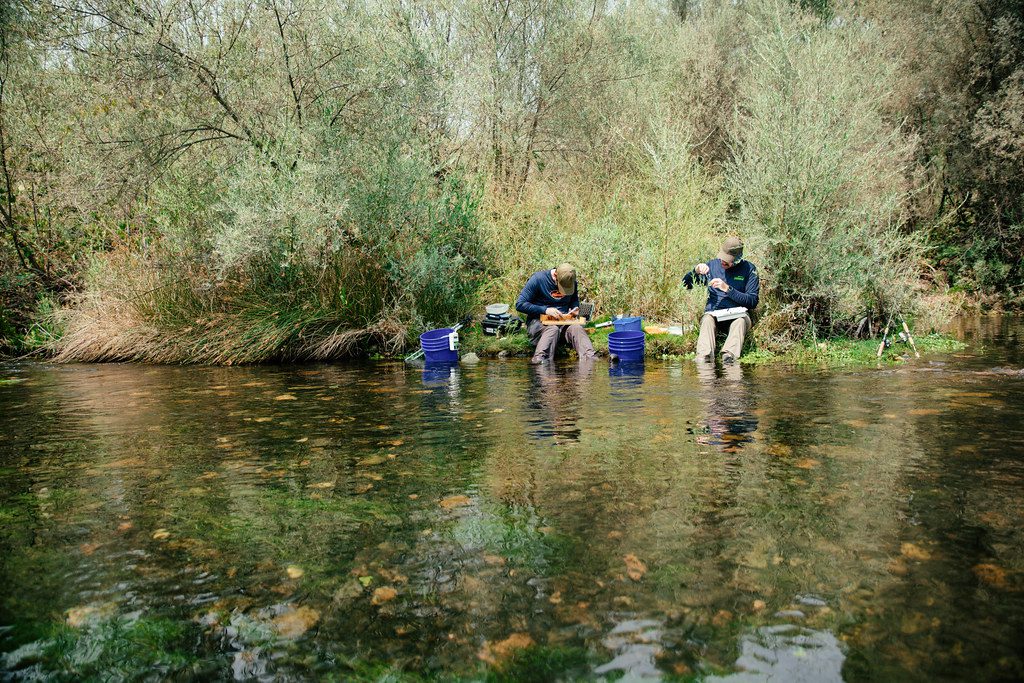Monday December 21, 2020

The past year has been challenging for the entire world, and for us at FISHBIO it has been no exception. Yet despite the difficulties of the coronavirus pandemic, shutdowns, and wildfires, we had the fortunate ability to continue much of our work surveying fish and rivers. Our family-style business came in handy when we could rely on a few family household teams to help us safely continue our long-term monitoring while navigating the early days of COVID-19. Once we figured out our new field protocols, we completed our 18th and 12th seasons of weir operations on the Stanislaus and Tuolumne rivers, respectively, as well as our 12th season of Stanislaus snorkel surveys and 12th season of Tuolumne redd surveys. We fabricated equipment such as a “passive fyke trap” tomonitor fish remotely, and also participated in several fish rescues, relocating 4,300 fish during one effort alone.
A major 2020 milestone was the completion of the Calaveras River Habitat Conservation Plan, after 13 years in the works. This agreement ensures both conservation activities and reliable water operations on the Calaveras for a 50-year period. We continued fisheries monitoring efforts on the Calaveras, including a life-history study of rainbow trout/steelhead in which we PIT tagged 650 trout and recaptured 16 of them. We also PIT tagged hundreds of bass in multiple studies using fyke traps and boat-electrofishing. We completed a snorkel survey of Big Chico Creek, installed an anti-spawning mat in the Sacramento River, and assisted in studies of green sturgeon and pikeminnow in northern California. On the Central Coast, we expanded our work in the Salinas River basin through eDNA sampling for steelhead and seining surveys for tidewater gobies and other fishes. We also installed and operated PIT tag antennas at three sites in Santa Clara County.
In Laos, we completed a project to establish a Fish Conservation Zone (FCZ) network on the Mekong River, consisting of seven freshwater protected areas managed by nine communities. We led an exchange visit for the project villages, organized Buddhist blessing ceremonies for the protected areas, and produced a video about the project. We also forged new partnership with the Wildlife Conservation Society in Laos, and are assisting them with developing community-led aquatic conservation in important wetland habitats. Our work for the Wonders of the Mekong project in Cambodia included the production of several short films, including documentaries on wildlife trafficking and wildlife conservation in Southeast Asa. In January we managed to complete community visits with indigenous territories in Costa Rica as part of a project to establish FCZs based on lessons from Laos.
On the scientific publications front, we published a study about salmon spawning based on seven years of redd surveys in the Stanislaus River (Peterson et al. 2020), as well as a review of effectiveness indicators to inform the evaluation of community-managed freshwater protected areas in Southeast Asia (Loury and Ainsley 2020). We also wrote a guidebook for the Critical Ecosystem Partnership Fund that synthesized lessons on how to establish FCZs with local communities, and produced a related video. While we had to scale back our usual homebrew activities and homemade goodies this year, our office landscaping in Oakdale received a nice makeover. Most of our office staff adapted to working at home for much of the year (sometimes with four-legged coworkers – can you spot them in our year-end video?), and we led and participated in virtual trainings, workshops, and conferences. Through all the changes and adjustments, we are deeply thankful for the dedication of our staff and the support of our clients and partners that allowed us to accomplish so much during a highly challenging year. We wish everyone a safe and restful conclusion to 2020!
This post featured in our weekly e-newsletter, the Fish Report. You can subscribe to the Fish Report here.
